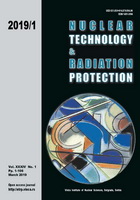
A GENERALIZED MATHEMATICAL MODEL FOR EFFICIENCY CALIBRATION OF GAMMA DETECTORS Application to Practical Cases
Pages: 34-46
Authors: Nikola N. Mihaljeviĉ, Slobodan I. Jovanovic, and Aleksandar D. DlabacAbstract
Efficiency calibration, i. e. determination of detection efficiency, ?p, is a crucial issue in gamma spectrometry (quantification of gamma spectroscopic measurements) with semiconductor and scintillation detectors. Comparing three possible ways to addressing the problem – relative, absolute and semi empirical - advantages of the latter are emphasized. Among semi empirical models, efficiency transfer using effective solid angles, ?, is sorted out and briefly elaborated. This approach reduces the problem of efficiency calibration to the determination of ?. It proved reliable and has been broadly used in practice, mainly in the form of the long existing ANGLE software. Progressing further, a generalized mathematical formula for calculations is developed – first of the kind – offering an opportunity for advanced applications of gamma spectrometry. The formula enables unlimited flexibility in application, as it conveniently separates the source data from the detector data during the integration procedures (? calculations). Its practicality is demonstrated for a number of typically encountered counting arrangements, as well as for some exotic ones. The relevant formulae are used in PC calculations and numerical testing is further performed so as to check the validity of the mathematical method and the computer code. Care was taken of the optimization of complex numerical procedures employed (involving fivefold numerical integration), so as to keep computation times as low as possible (in order of minutes or even seconds on ordinary PC). Results obtained are affirmative for both the method and the code. The model will be gradually in corporated into ANGLE software, thus making it readily available for routine use by gamma spectrometry community.
Key words: gamma spectrometry, detection efficiency, detector calibration, mathematical model, numerical testing, applicability, ANGLE software
FULL PAPER IN PDF FORMAT (1,14 MB)
